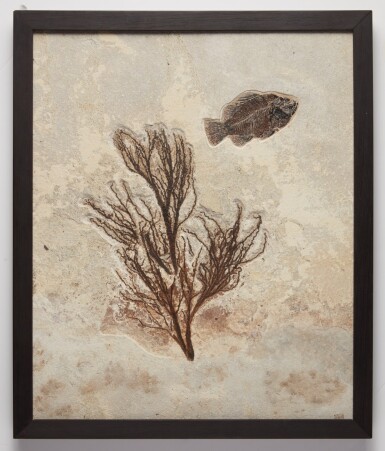
A Fossilized Bass and Algae Plaque
Lot Closed
December 3, 07:30 PM GMT
Estimate
12,000 - 18,000 USD
Lot Details
Description
A Fossilized Bass and Algae Plaque
Priscacara liops, Phaeophyceae
Early Eocene (approx. 50 million years ago)
Kemmerer, Wyoming, United States
Priscacara liops: 6 by 3 inches (15.2 x 7.6 cm); Phaeophyceae: 15 by 12 inches (38 x 30.5 cm); 26 by 22 by 2 inches (66 x 55.9 x 5 cm) in matrix. The plaque comes in a dark wood frame and weighs 45 pounds (20.4 kg).
Both the large algae bloom and the Priscacara liops are well-preserved, with the fish clearly displaying its scales, fins, spine, and skull.
Priscacara liops is an extinct species of bass known primarily from the "Fossil Lakes" of Wyoming's Green River Formation. With squat fins and spines, this Eocene fish resembles a modern-day sunfish. Based on death-assemblage fossils, it is likely that this species lived in large schools, swimming through colonies of the brown, multicellular algae, Phaeophyceae. Today, this class of over 2,000 different types of seaweed act as both a food source and a habitat for countless marine animals. Less is known about its specific role in North America's Eocene ecosystems, as the soft-body of this algae seldom fossilizes, making the specimen offered here a fine opportunity to own a piece of a 50 million year old ecosystem.
